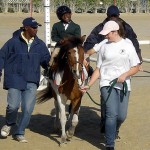Certainly we all want to be more authentic — that is to say what we mean and mean what we say. Further, although there a number of approaches, and no less written about becoming more authentic, there are not so many ways to understand how to feel authentic. Enter equine therapy. For when working with horses, very little is communicated verbally, and instead the relationship with the horse is almost exclusively conducted through feel.
Because of this felt communication that exist between horses and humans, equine therapy presents a unique opportunity for a person to experience what is authentic for him/her. However, in order to do this, it is first necessary to understand and interpret the responses of the horse correctly. The horse’s behavior must not be analyzed through our narrow lens. When this occurs, interpretations become not only our own projections, but also fall into the category of anthropomorphism.
So we must look at the horse first in his natural environment — that is, in a herd of other horses. Then we must be able to know what is meant by his behaviors in this setting. For example, when the horse circles another, raises his head, shakes his head, paws at the ground, what is he trying to say to the horses around him? However subtle all of these behaviors may seem, they all have a very distinct purpose.
Recognizing and understanding the horse’s behavior in the herd is imperative because to a horse, being around people does not dictate another language. Instead, when with people, the horse uses the same communication system that is adopted in the herd. And while watching a herd of horses, is should also become evident that again, this communication system is nonverbal. What this means is that the horse relies on what is felt — through his physiological system — to understand what is being “said” to him, and what he is “saying” in return.
Continue reading Equine Therapy: A Path to Authenticity, by Claire Dorotik




